After the war's end, the production of Il-2s continued for some time, leaving gradually space to the newer Il-10 that was introduced into production in summer 1944.
The production of Il-2 stopped: in Zavod 1 in June 1945, in Zavod 18 in July, in Zavod 30 in October, after a total of 36,154 planes.
Il-2s were supplied to some of the postwar allied countries of SSSR: Poland, Czechoslovakia, Bulgaria, Yugoslavia and Mongolia.
Il-2s remained in service in SSSR for some time, up to mid 1948; to prolong their life, an unknown number (perhaps about 1600) of metallic rear fuselages were built in Zavod 30; part of them were for UIL-2s.
It is thought that the postwar Soviet Il-2s were repainted with gloss green (AGT-4 or A-24g) solid uppersurfaces as Il-10s, but there are nearly no photos available.
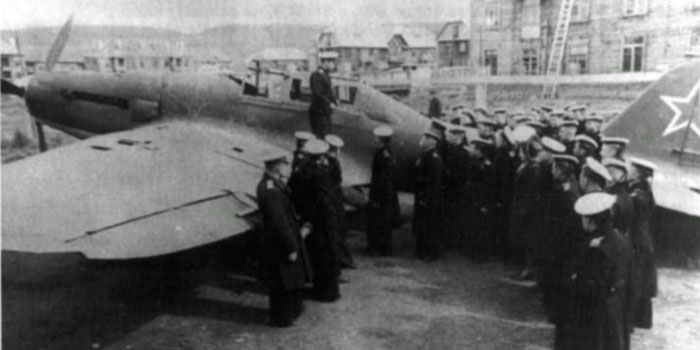
This UIL-2 in a military school in Leningrad, 1948, seems repainted in overall green uppersurfaces. It presumably had a metallic rear fuselage. Seems that the transparent panels and the antenna mast have been removed for didactic purposes.
It's the only image we have on a postwar Il-2.
Image from Ilyushin Il-2 and Il-10 Shturmovik by Y.Gordon and S. Komissarov, ed. Crowood.
A profile of this plane.
To see a larger 3-views drawing, click on the profile.
Nominally, Polish Attack Air Regiments equipped with Il-2s were instituted in 1944, when 611th, 658th, 382nd and 384th ShAP of VVS were used to create Polish 3rd, 6th,7th and 8th Regiments; they bore Soviet stars, but were recognizable for small Polish markings on their nose; anyway, they were largely staffed by Soviet crews due to the lack of trained Polish ones.
Another unit was equipped with Il-2s in June 1945.
In 1946, the units of Il-2 in the Polish Air Force (Lotnictwo Wojska Polskiego) were reduced to 3 (4th, 5th and 6th Regiments).
The Il-2s in Polish Air Force reached 178 Il-2M3 and Il-2KR, and 24 UIL-2; they began to be supplanted by Il-10s in 1949.

The planes shown in this screenshot are of 2nd Polish ShAD (a Polish personnel unit within Red Army).
The first plane, white 2, is a straight-winged one with short radio mast; the camouflage and markings are of the type introduced in August 1943; the plane could have been built in August or September 1943.
The shape of the hood of the tail wheel suggests that this plane was built in Zavod n.1 and had wooden wings.
The second plane, white 7, has a long radio mast, smaller stars and a different tail wheel fairing and camouflage not strictly following the standard templates; it seems to be built by Z. 18, so it probably has metal wings; this variant can be identified as a bit later of white 2, due to the longer mast.
A reconstruction of plane n.2.
The use of blue for the spinner is hypothetical, it looks too dark to be white as the outline of the star on the tail and the spinner of 7.
Click on the profile to see a larger 3 views drawing.
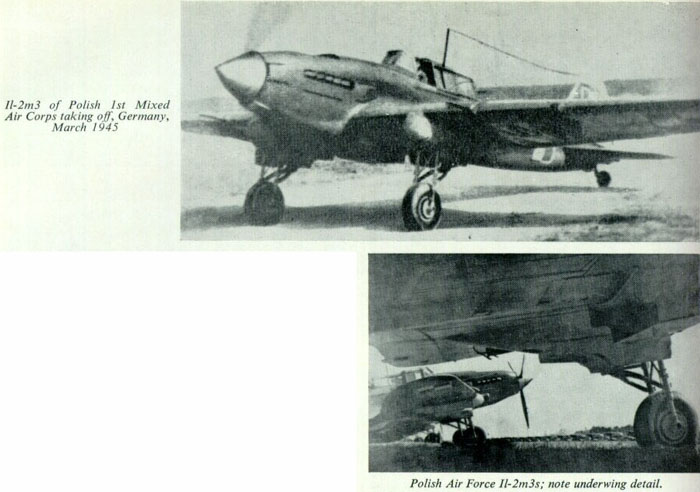
According to the captions of Profile Publications n.88 on Il-2, this plane was photographed in March 1945, still during the war, and bears full Polish marks.
The date of this photo is questionable, because the plane looks to bear a postwar uniform green upper surface.
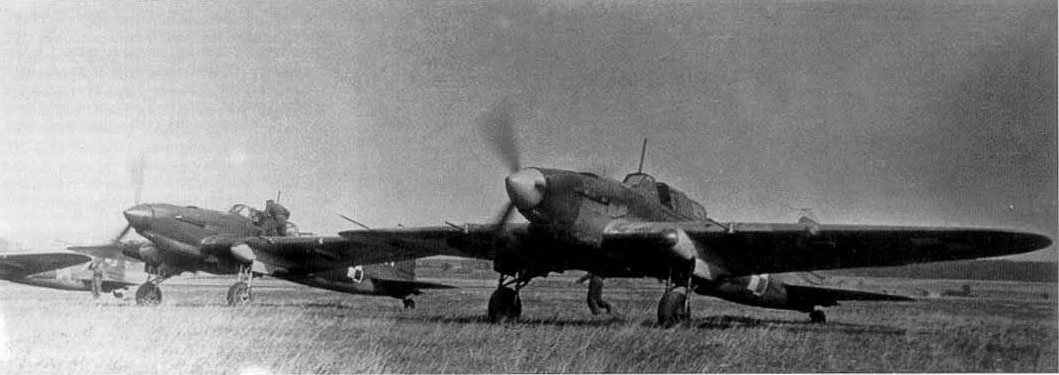
A line of Polish Il-2s. The camouflaged one is the Il-2KR of the photo below, while the second plane looks to have already received the postwar uniform gloss green livery.
Image from Monografie 4+ : Il-2M3 Shturmovik
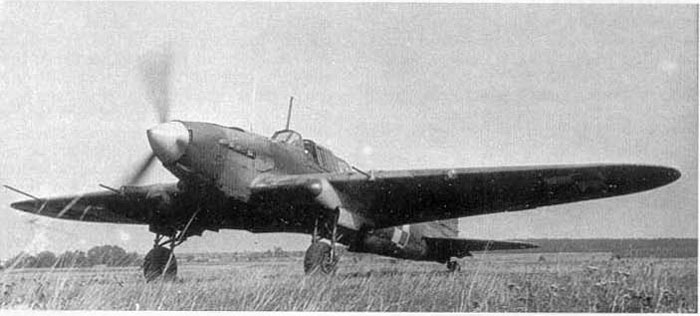
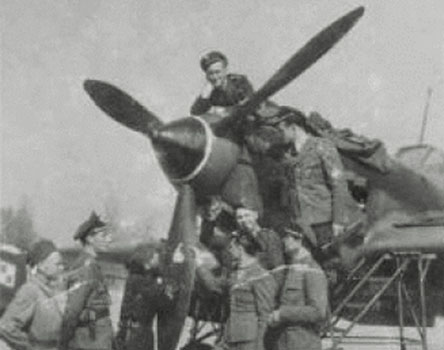 Polish
AF received some Il-2KR spot artillery planes, characterized by a more
powerful radio apparatus, a ventral circular window and easily recognizable
for the radio mast located on the windshield.
Polish
AF received some Il-2KR spot artillery planes, characterized by a more
powerful radio apparatus, a ventral circular window and easily recognizable
for the radio mast located on the windshield.
Left: this plane bears still the Soviet wartime camouflage with Polish markings.
Image from Monografie 4+ : Il-2M3 Shturmovik
Right: another Il-2KR. It's difficult to say if this is camouflaged too.
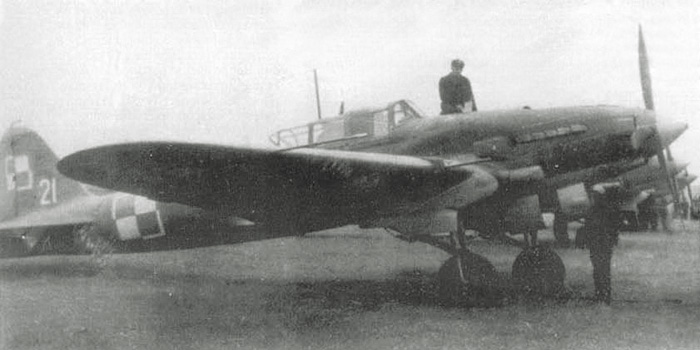
Il-2 N.21, apparently with the postwar green livery. It seems to have yellow cap and front of the spinner. The plane looks built in Zavod 1 because of the shape of the fairing of the tail wheel.
Image from Monografie 4+ : Il-2M3 Shturmovik
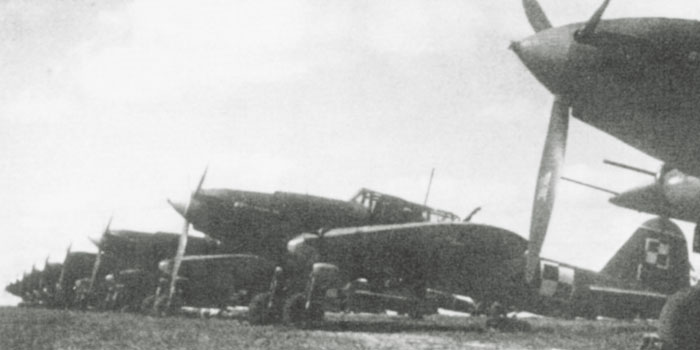
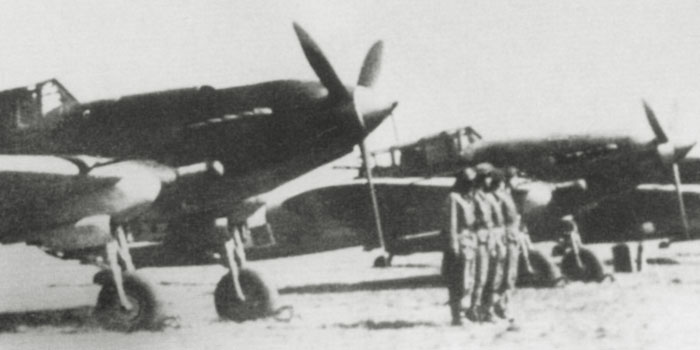
Other images of Polish Il-2s. The front of the spinner looks much variable in color: the first one looks red, the second one yellow with a thin white line, other ones seem white.
A white 1 can be read on the fin of the second plane.
Another photo. We see again a strong variability in the colors of the spinners.
Image from Monografie 4+ : Il-2M3 Shturmovik
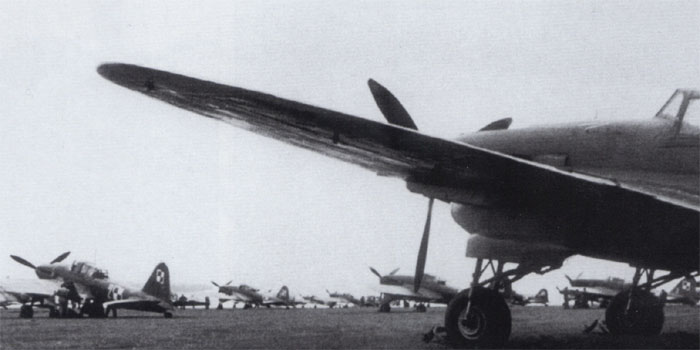
This photo shows some interesting details: the closer plane, although resembling painted with uniform green uppersurfaces, has still the white aiming lines painted on its nose.
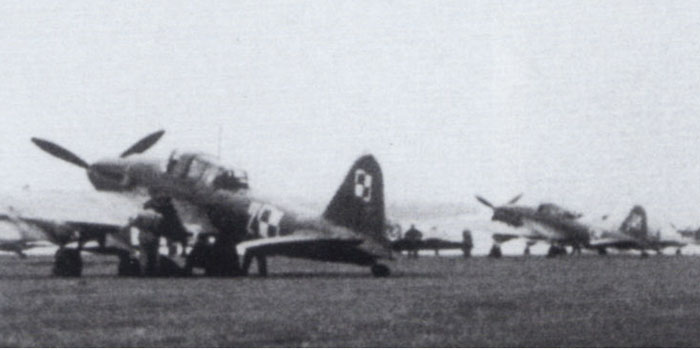
A closed detail of a plane with a number 2 painted on the fuselage sides instead of the fin. Unfortunately it's not clear if it is painted green or camouflaged.
Image from Monografie 4+ : Il-2M3 Shturmovik

Photo of plane White 13 after a bad landing.
It's not 100% sure that the plane was repainted green, because the photo shows some disuniformities; anyway the gloss finish is in favor of a postwar full repainting.
A reconstruction of plane n.13.
Click on the profile to see a larger 3 views drawing.

A photo of a Polish UIL-2, possibly White 21, probably after the war's end. The plane still features the wartime three shades camouflage, although with the characteristic non-repetitive style of Z.18 and with evidence of repaintings.
The photo seems to show a strange fairing in front of the canopy rails, but this could be a defect of the photo because it don't appear on other images of UIL-2.
The plane is only partly visible in the photo, so my attempt to draw it takes in considerations photos of other Polish Il-2s, that have often colorful spinners changing from plane to plane, and a colored cap on the tail.
Click on the profile to see a larger 3-views drawing.
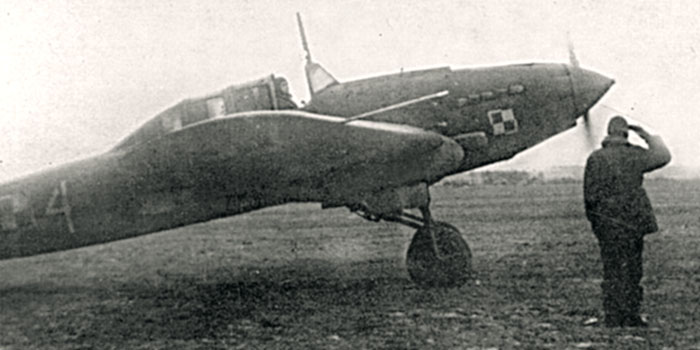
Another Polish UIL-2 'White 4', probably camouflaged as the previous one. The small Polish mark on the nose suggests that it could have been flown with red stars as national markings during the war.
from Lotnictwo z szachownica 5, via Vitaliy Timoshenko

The tail of Il-2 n.3. It has an uniform green uppersurface, a white cap and an interesting yellow (?) leading edge of the fin.
The tail wheel fairing suggests a plane of Zavod 18 or 30.

An Il-2 is preserved in the Museum of Warsaw, but it is stored in the open air and in not so good conditions. The uniform olive green has turned to brown, while the canopy struts, rudder, elevators and part of the tail have been repainted with a dark emeraldish green to preserve them; clearly this painting can't be considered as a credible reproduction of a serviceable one.
Czechoslovakia
Czechoslovakian Air Attack Regiment was instituted in September 1944, and it became part of the newly formed 1st Czechoslovak Air Division in January 1945. The unit, still with Red Stars emblems, had a limited combat life, the first sortie being flown only in April 1945.
In July 1945 the regiment passed under the authority of the Czechoslovak Ministry of Defense and renamed as 30th Ostrava Attack Air Regiment of the Czechoslovak Air Force (Ceškoslovenske Vojenske Letectvo)
It was based at Trencanške Biskupice, and had in force 24 Il-2M3 and two UIl-2, that were renamed as B-31 and CB-31 respectively.
Some of the planes were updated with new LR-16ZY German radio equipment.
The planes were phased out in 1948-49, replaced by Il-10s.
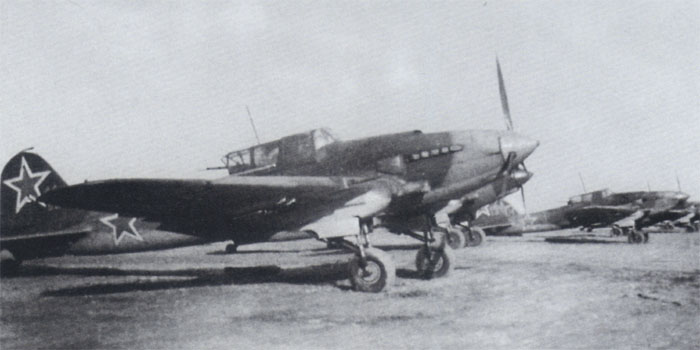
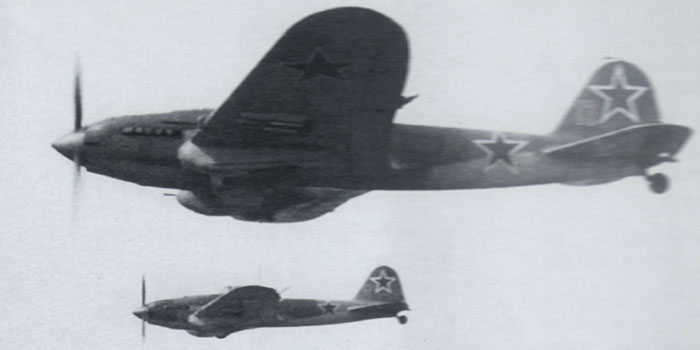
Planes 11, 13 and 14 of the Czech unit photographed in Poreba airfield, Poland, on April 26, 1945.
At least two planes of the unit have their masts bended rearwards.
The planes look built in Z.1.
the bort numbers on the tail have a colored inside (light blue?) with a white outline.
(Photo from 4+ Publications-Ilyushin Il-2 Shturmovik)
Another image showing planes 13 and 17 in flight.
The typical shape of the tail wheel covers of Z.1 is recognizable; the leg roots are covered by flexible boots.
(Photo from 4+ Publications-Ilyushin Il-2 Shturmovik)

Plane blue 30 was shot down by the German AA during an attack on Privoz on 28 April 1945.
The pilot Sgt. Jarolim Gucman was killed by the explosion of the fuel tank during an attempt of belly landing, while the gunner, Corporal Jan Valko, survived although heavily injuried.
Image from Squadron Signal Il-2 in action.
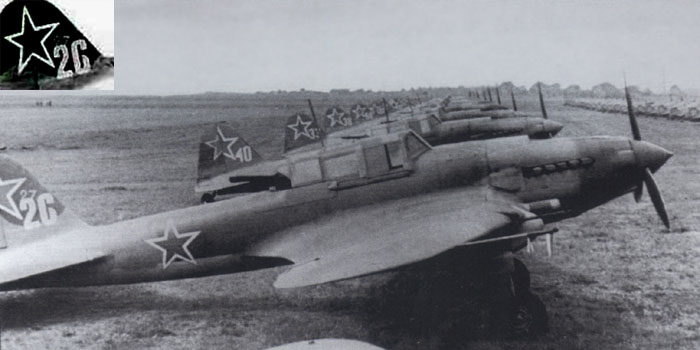
A line of Il-2M3s of the 3rd ShAP, the only Czech unit equipped with Il-2s. The photo is taken in Prague-Letnany airfield on June 1, 1945.
There is a small oblique number '27' just above the large 26 on the tail of the first plane. A repainting on the rear fuselage suggest that 26, or another number, could have been painted here too.
The first impression of the bort numbers visible on the photo is that they are uniform white, but at a closer look the inner part seems darker, possibly light blue.
In the darkened detail one can see the inside. The small 27 is scarcely visible, being darker than the 26.
Although the tail wheel is not visible, the style of camouflage suggests a plane of Z.1. Note that the antenna mast is slightly bended rearward; there is evidence of repainting just behind the star of the fuselage side.
(Photo from 4+ Publications-Ilyushin Il-2 Shturmovik)
A reconstruction of this plane.
Click on the profile to see a larger 3 views drawing.
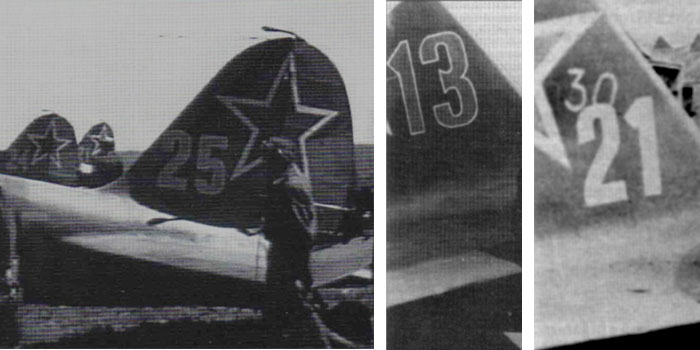
Details of some bort numbers of Il-2s od the Czech unit in spring/summer 1945.
25, 24 and 31 show a light color inside the white number. The 25 is reported on the fuselage too.
13 looks clearly a darker inside. although lighter than the red of the stars.
21/30 looks uniform white.
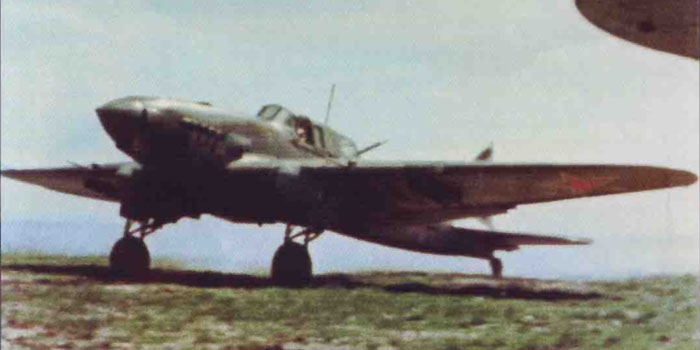
This color photo was taken in Prague, July 1945; this image suggests that blue-grey could really have been utilized in substitution of the brown. Unfortunately, there is no guarantee that this color photo is real; it likely is a colorized b/w photo.
(Photo from 4+ Publications-Ilyushin Il-2 Shturmovik)

LX-16 was built in Z.18 with the s/n 18882116 in late 1944.
It belonged to 1st Squadron, 30th Air Regiment, at Trencin.
It belly landed on July 29, 1947.
Image from Monografie 4+ : Il-2M3 Shturmovik

Plane LX-17 (s/n 18894113) was built in Z.18 too. It belonged to 30th Regiment in September 1949.
The inscription B 31-18894113 is clearly readable on the left side of the nose.
Noteworthy is the emblem, very similar to that worn on MiG-15s of the same unit.
The aerial under the wing is of LR-16ZY radio equipment.
Image from Monografie 4+ : Il-2M3 Shturmovik
A reconstruction of LX-17.
Click on the profile to see a larger 3 views drawing.

This B-31 takes the part of a Fairey Battle in the movie Nobody knows anything of 1947. It wears false British roundels and (reversed) fin flag, and wide yellow bands on uppersurfaces (instead of the roundels). The spinner has red-blue bands on its front part.
Image from Monografie 4+ : Il-2M3 Shturmovik

Il-2M3 s/n 12438, built by Zavod 1, is preserved in the museum of Prague-Kbely.
The plane has a wooden rear fuselage and metallic arrow-shaped wings; it shows some very late characteristics, as the UB machine gun with a pneumatic arming device over the barrel, nearly never seen in wartime, and extended trim tabs on the elevators (the date of start of production of Il-2s with extended tabs is uncertain). The fingernail shaped cover of the tail wheel is typical of Il-2M3 produced in Z.1.
The plane was repainted with a not original camouflage of dark green and dark red brown, according to the misconceptions of the age about the painting of Soviet planes. It wore this livery up to 2005 when it was restored.

The restoration of 2005/2006 was made conformal to the three-colors template of summer 1943.
The pattern is very accurate for a plane built in Zavod 1, but the choice of the shades is rather questionable. The brown should be lighter and much less reddish, while the grey should be much darker.
Image from Monografie 4+ : Il-2M3 Shturmovik
A color drawing of the plane as restored in 2006.
Click on the profile to see a larger 3 views drawing.
Bulgaria
After having fought on the Axis side, Bulgaria changed its government ant started to fight aside the Soviet Union.
During 1945, 120 Il-2s and some UIL-2s (up to 10 according to some sources) were delivered to the new Bulgarian AF (Balgarski Voennovazdushni Sily).
Part of the planes (80) were later delivered to the Yugoslavian Air Force as compensation for war damages.
Some Bulgarian Il-2s had their wooden rear fuselages replaced with new metallic ones built in Yugoslavia, and were in service up to 1954.

This image of early Bulgarian Il-2s is the only one available that can help us how early planes of this Air Force appeared. We see planes with (presumably) the original Soviet camouflage, red or black spinners, early markings with a green-red-white cockade and bands on the higher part of the tail. Bort numbers, if any, are undetectable but they could have been painted on the fuselage sides, being hidden by the wings on this photo.

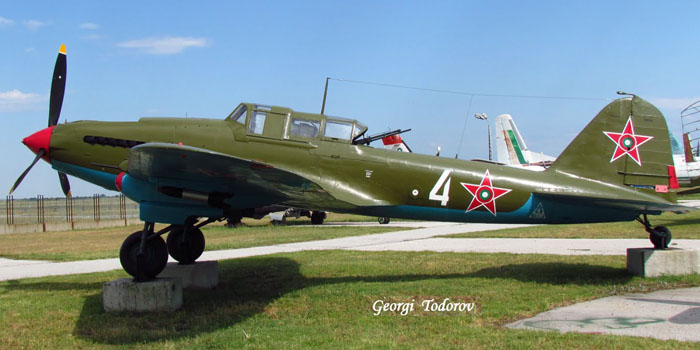
An Il-2 finely restored in a Bulgarian museum. It gives a credible reproduction of a serviceable Bulgarian Il-2 of late '40s, apart for the blue that looks a bit too saturate and the lack of the nail in front of the tail wheel.
This plane has a metallic rear fuselage, probably obtained from Yugoslavia that build then at Ikarus plant.
A drawing of the plane restored in the museum, giving a credible idea of a serviceable one.
Click on the profile to see a larger 3 views drawing.
Yugoslavia
From 1944, some hundred of Yugoslav pilots and technicians were trained in Soviet Union at Krasnodar, resulting in the formation of two Air Attack Regiments, 421 and 422 ShAP, that saw action against Germans.
The Yugoslav Air Force (Jugoslovensko ratno vazduhoplovstvo, JRV) was instituted on January 5, 1945, incorporating many air units of the Yugoslav Liberation Army.
On May 14, 1945, the 421 and 422 ShAP passed under the control of the Yugoslavian government, aside all the planes and materials of the 10th GvShAD; this included 78 Il-2s and 4 UIl-2s.
A dozen of Il-2s were later converted into UIl-2s in Yugoslavia.
Further Il-2s were later delivered by Soviets and 80 from Bulgarians , for a total of 260 Il-2 and 36 UIL-2, and remained into service up to 1954.
After the end of Soviet-Yugoslavian alliance in 1948 interrupted the supply of parts and planes from the SSSR, so the Yugoslavian industry Ikarus started to produce metallic replacement parts, including metallic rear fuselages.
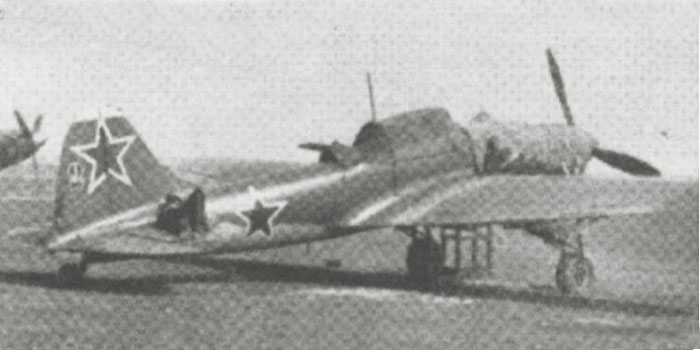
An Il-2 of Yugoslav Air Force still in Soviet marks on the airport of Zemun, probably in 1945.
A profile of the same plane. The white tip of the spinner was traced for similarity with other planes of the same unit, but it's uncertain on this one.
Click on the profile to see a larger 3 views drawing.
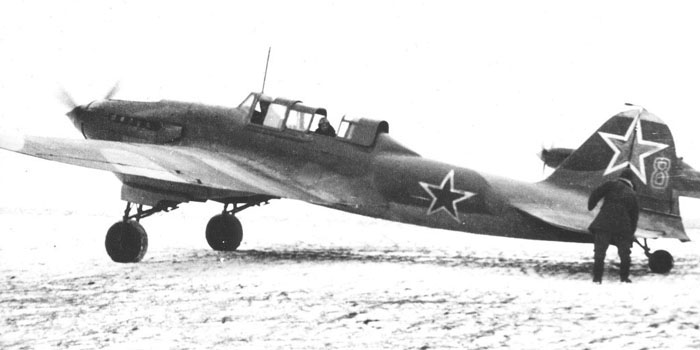

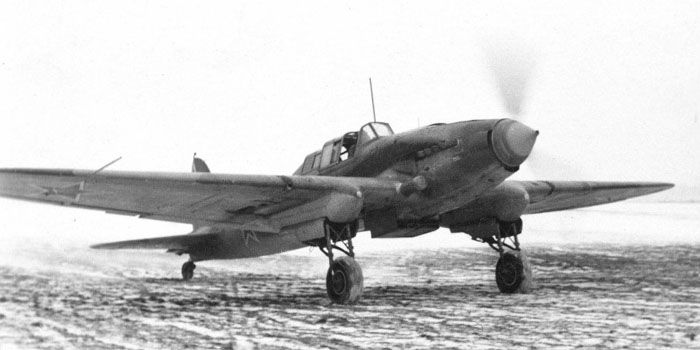
UIL-2 of Yugoslav Attack Aviation Training Center at Zemun airport, near Belgrade in December 1944, still utilizing Soviet stars.
The sliding hoods are a mix: the rear one is the fully-armored type of usual Il-2s, while the front one has the upper armor preserved, and fully transparent sides; half panel is slided back and let see the pilot directly. The windshield is armoured and the rear part is of late type with small windows.
The wing is of straight type, as one can state seeing that the hinging lines of the aileron and of the flap appear perfectly aligned; arrow wings show a step between these lines. The landing light window on the left wing looks rounded, so probably the wing was of wooden type.
Strangely, there are black traces of stain from the slots of the VYa-23 guns, but the guns themselves and their fairings aren't there; probably a smaller arm (UB or ShKAS) was installed there.
The smaller slots for the ShKAS above the leading edge don't show a protruding barrel, the ShKAS could have been removed from these positions.
(Photo from Micevskii's collection)
http://www.mycity-military.com/Drugi-svetski-rat/Il-2-Leteci-tenk.html
A profile of Red 8.
To see a larger 3-views drawing, click on the profile.
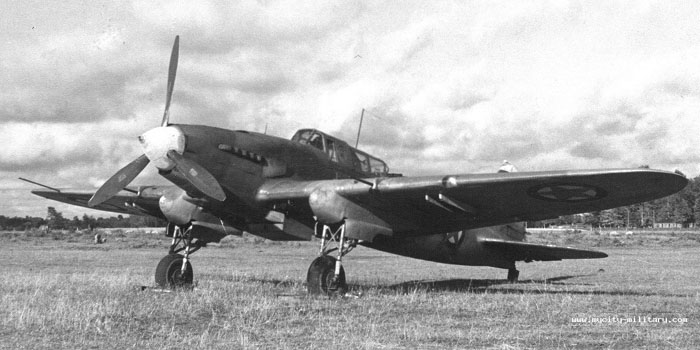
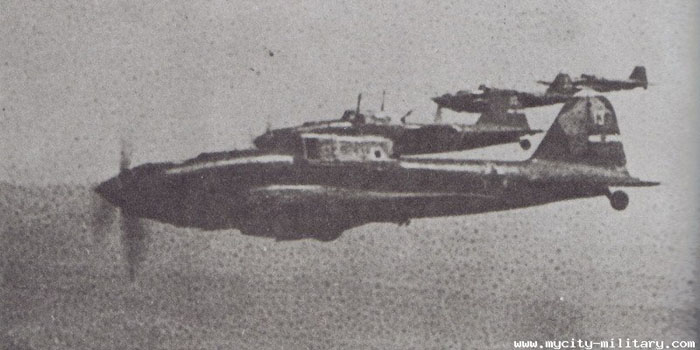
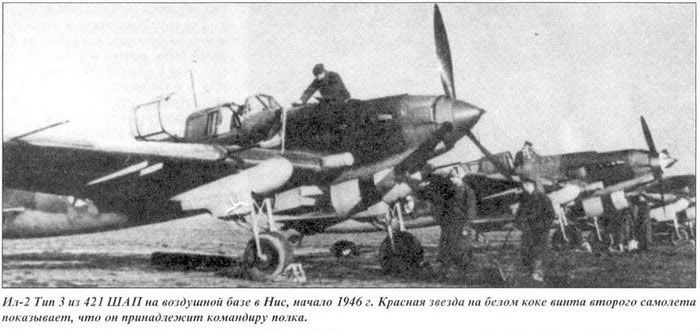
Planes of the newly born Yugoslav Air Force, presumably in late 1945.
They shows still the Guards emblem on the canopy sides because they are from the former Soviet 10 GvShAD; the Soviet red stars are overpainted with some color, probably grey.
Note that early Yugoslav markings hadn't the yellow outline around the red stars; such outlines were a later addition.
http://www.mycity-military.com/Drugi-svetski-rat/Il-2-Leteci-tenk.html


Plane 27 with the new marks over the old ones deleted with grey (?) paint. The Guards emblem is still visible on the armour of the canopy.
The red stars haven't the yellow outline, but the blue ring is interrupted around the upper arm of the red star on the fuselage. It's unclear if this happened on the other stars too.
http://www.mycity-military.com/Drugi-svetski-rat/Il-2-Leteci-tenk.html
Another photo of 27 putting into evidence that the spinner was painted with two unidentified light colors, possible white and yellow.
The light spot on the tail could be due to a repair, and could appear as yellowish putty.
It's unclear if the aiming line on the nose were preserved on this plane.
http://www.paluba.info/smf/index.php/topic,10775.15.html
A profile of this plane.
To see a larger 3-views drawing, click on the profile.
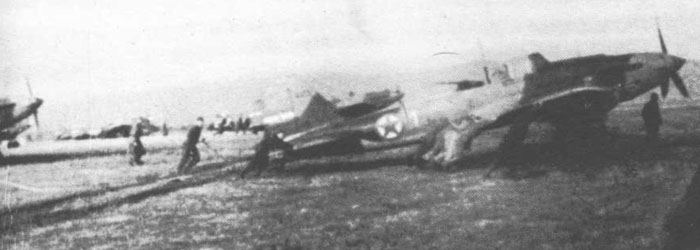
These Il-2s, photographed in 1946, show a new livery. It is unclear if it is from the NKAP template of 1945, that is very resembling but prescribes grey-grey uppersurfaces (AMT-11 and 12) as on fighters, or it was executed with medium grey and dark green as on other postwar Yugoslav planes.
http://www.mycity-military.com/Drugi-svetski-rat/Il-2-Leteci-tenk.html
A profile of this plane.
To see a larger 3-views drawing, click on the profile.
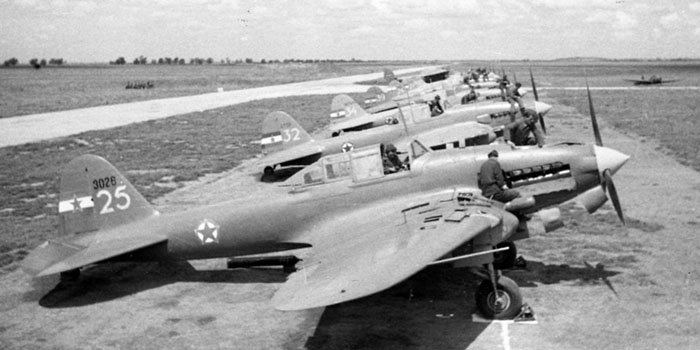
A line of Il-2 and UIL-2 of Yugoslav Air Force in 1948.
The UIL-2 in first position shows unarmored sliding hoods with armoured windshield, and a wooden rear fuselage.
The first plane is noticeable also because the blue and red of its markings are by far less contrasting than those of the planes on the background.
Note that this plane has the wings from a single seater built in Zavod 18, as recognizable for the flushed gun fairings; the guns were not installed, only the smaller ShKAS machine guns. The plane has noy the VV-1 external aiming device nor the white aiming lines on the nose; it's unclear if it had rocket rails, that appear on a photo of another Yugoslav UIL-2.
Perhaps this plane was converted as a trainer from a normal Il-2.
http://www.mycity-military.com/Drugi-svetski-rat/Il-2-Leteci-tenk.html
An interpretation of white 25.
Click on the profile to see a larger 3 views drawing.
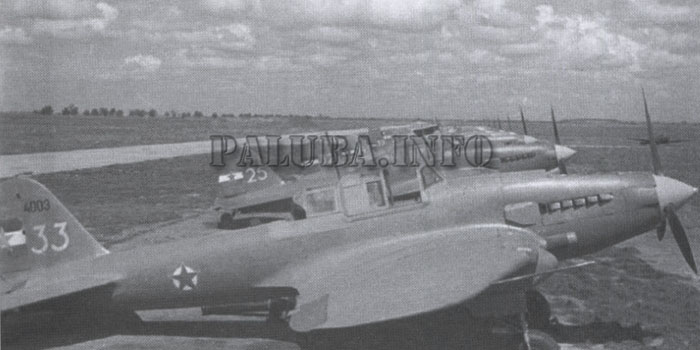
Another image of the same line.
In first position we see plane 33/4003, still with wooden rear fuselage.
This Il-2M3 is characterized by gun fairings in the style of Z.1 or 30, but the VYa-23 guns and the rear UB are not installed; probably the smaller ShKAS on the wings were retained, for similarity with plane 25; it's unclear if the rails for the rockets were retained.
Note the absence of the VV-1 external aiming device and of the white aiming lines on the nose.
Note also the light grey repaintings around the canopy, and the dark grey ones on the ailerons, rear fuselage and tail.

An interpretation of white 33.
Click on the profile to see a larger 3 views drawing.

Two images from a movie in 1948.
A Yugoslavian Il-2 on exercise has painted TI*TO on the left side and PAR*TIJA on the right, meaning “Tito - party” (communist party, only party back then in Yugoslavia), and it was a very popular motto among the crowd at mass gatherings.
We can read a white K on the side of the fin instead of a bort number.
The serial number on the tail, although not readable here, is known to be 4156 from a Yugoslavian magazine. This source gives FS-35450 for the blue of the undersurfaces, and 35237 for the uppersurfaces. The ring aerial, well visible in front of the tail, confirms that this plane had a metallic rear fuselage, as expected for a plane in service in 1948.
http://militaryaviation148.blogspot.it/2013/07/il-2m3-no-4156-jrv.html
http://www.mycity-military.com/Drugi-svetski-rat/Il-2-Leteci-tenk.html
Thanks to Aleksandar Ilic

A collage of details from screenshots of Yugoslav movies.
We can recognize the codes of plane 61/4061, and of planes 19 and 32 (unknown serials) that were painted small and close to the tails. the ring aerial and the panelling on the fin show that this plane had a metallic rear fuselage.
An image shows that white aiming lines were preserved on Yugoslav Il-2s.
http://www.mycity-military.com/Drugi-svetski-rat/Il-2-Leteci-tenk.html
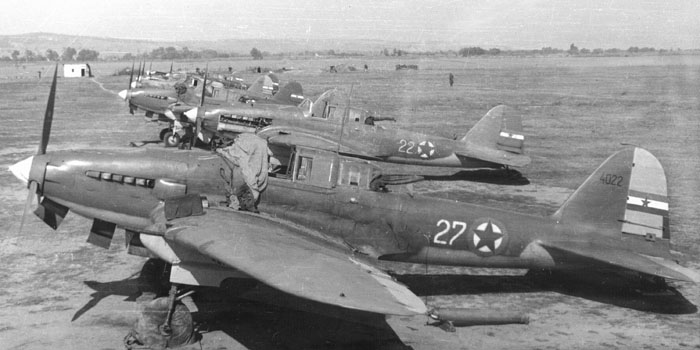
A line of Il-2s.
Plane 27/4022 has a light rudder seen on other Il-2s too; it can't be an illusion due to the light, because the rudder is locked in straight position. Someone interpreted it as a bright color, but we can see that the fabric-covered elevators and ailerons seems to show the same shade, so probably it is a repainting with a lighter shade of grey for maintenance purposes. The trim tab seems painted red. Plane 27, well visible in an high resolution scan, has a wooden fuselage.
The white tip of the spinner is noteworthy too.
The second plane is n.22, without any serial on its tail, probably deleted for a lighter retouch on the tail and upper part of the rear fuselage. It has already received the new metallic rear fuselage, easily recognizable for the ring aerial in front of the tail.
On both the planes, the gun fairings are typical of Z.18.
Image courtesy Aleksandar Ilic
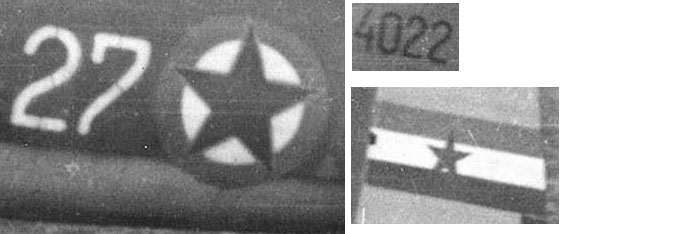
A detail of the markings of this plane. Seems that the yellow outline is present on the fuselage stars of this plane, while it is unclear if it was on the tail starlet too.
Both the digits of 27 and 22 reveals small interruption, revealing that they are painted by stencils.
The star of plane 22 seems without any light outline; its blue ring looks a bit thinner than that of 27, and the flag on the tail seems to show slightly different proportions.
Profiles of planes 27/4022 and 22 depicted in the photos above.
To see larger 3-views drawings, click on the profiles.
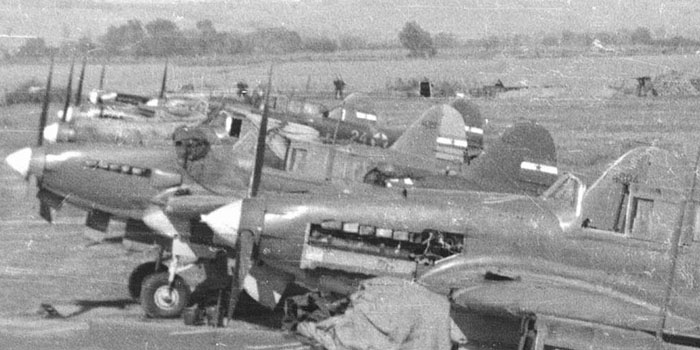
A detail of the other planes of the line.
The third plane, with medium grey finish, is 4804. The gun fairing is typical of Zavod 1 or 30.
The fourth one, with dark grey rear fuselage but medium grey front, has an hardly readable code on the tail; it looks to have a light cover on its nose. It has the ring aerial that reveals its metallic rear fuselage.
The fifth one, with light grey rudder, seems coded 4025. It seems without the ring aerial.
The sixth plane is numbered 24 on the fuselage has an unreadable tail code; its finish looks dark grey, but the front half of the nose is light grey.
The seventh plane numbered 1 on its tail is a smaller type.
the eighth plane is in medium grey, with an uncovered engine; no any code is readable.
Image courtesy Aleksandar Ilic

A detail of the tail of an old, faded and chalky Il-2 with grey livery.
Note that the red starlet on the tail is without any outline. The red and blue stripes are nearly undistinguishable from the grey background.
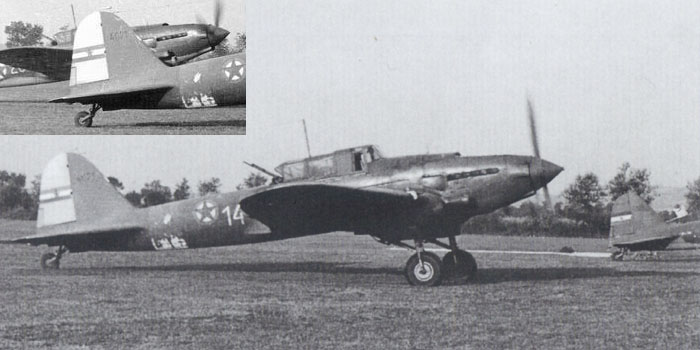
Plane 4021/14 in 1949 during an exercise.
According to the caption of 4+, from which the photo is, the plane was painted with dark grey and light blue and with a yellow rudder.
The plane on the background, n.4026, is under the same light and the blue undersurface is perfectly recognizable, differently from 4021/14. The detail above shows another plane (20?) moving behind 14, and it's clear that the dark undersurfaces of 14 aren't a joke of light.
My idea is that all the plane, including the blue undersurfaces, is covered by a thin layer of black or very dark grey, that has adhered badly on a previous white band on the fuselage. The rudder was probably repainted light grey for maintenance, and so could have been the upper parts of fabric skinned surfaces, as seen on other photos of planes probably of the same unit. The tail seems not overpainted with the blackish paint, showing its previous dark grey finish with light grey repainted movable surfaces. It's likely that the aiming lines and the supposed light uppersurfaces of ailerons were overpainted by the trasparent blackish paint.
This dark repainting was probably due to an experimental livery for a night intruder.
A profile of this plane.
To see a larger 3-views drawing, click on the profile.
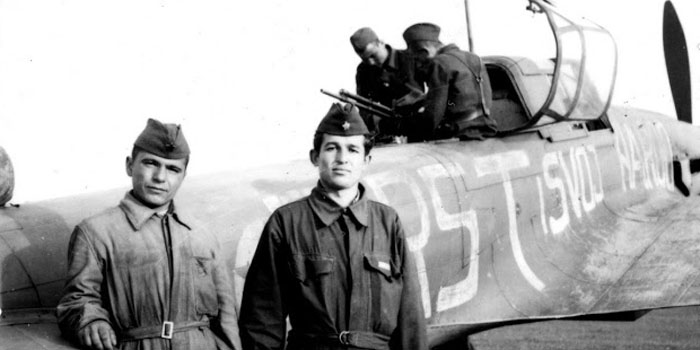
Il-2 of 96th regiment in fall of '53 during the Trieste crisis. During that crisis, a lot of old and even written off Il-2s were put in flight conditions.
The slogan reads "Ne damo Trst i svoj narod" that means: "We don't give in Trieste and our people".
Unfortunately, the bort numbers of this plane are not shown in the photo.
http://militaryaviation148.blogspot.it/2013/07/il-2m3-no-4156-jrv.html
http://www.mycity-military.com/Drugi-svetski-rat/Il-2-Leteci-tenk.html
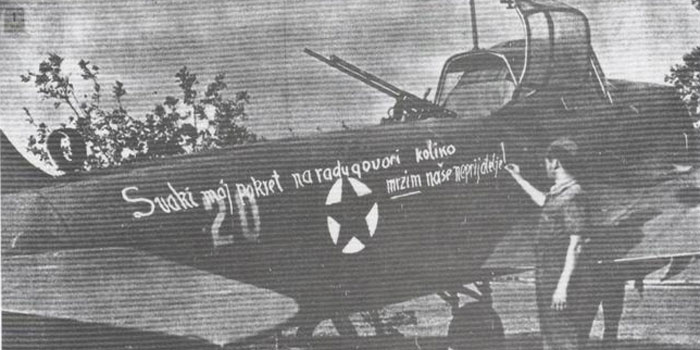
Plane n.20 with a slogan: “Svaki moj pokret na radu govori koliko mrzim naše neprijatelje!”, which means “ Every my move at work tells how much I hate our enemies!” .
Image via Aleksandar Ilic

An Il-2M3 on restoration in the Museum of Belgrade.
This image allows to see well the metallic construction of the rear fuselage
http://forum.il2sturmovik.com/topic/1527-aeronautical-museum-belgrade/
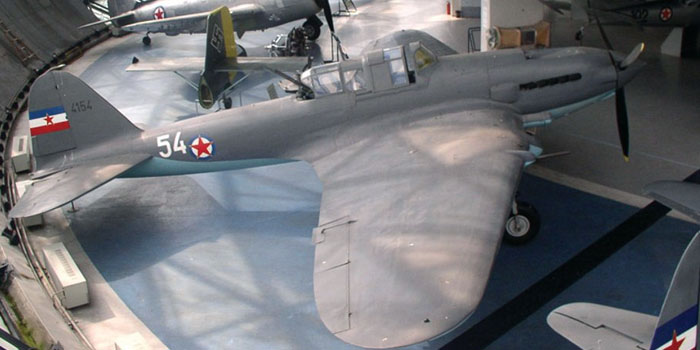
The plane finely restored in the museum of Belgrade. The uppersurface is uniform grey similar to AMT-11. Note the absence of the ring aerial in front of the tail.
http://www.muzejvazduhoplovstva.org.rs/eksponati.php?jez=eng&id=18
http://vvs.hobbyvista.com/Research/Ilyushin/Il-2/Walkround/Serbia/
http://www.britmodeller.com/forums/index.php?/topic/72705-ilyushin-il-2/
A drawing of white 54.
Click on the profile to see a larger 3 views drawing.
Mongolia
A derelict fuselage of Il-2 is said to have been preserved in the Ulan Bator airport.

Photo of Mongolian Il-2s. (from Ilyushin Il-2 and Il-10 Shturmovik, Y.Gordon and S.Komissarov, ed. Crowood).
Plane 24 looks made by mixing pieces of different planes: the front part is camouflaged and shows the typical gun fairings of planes built in Zavod 18, while the rear fuselage is metallic (recognizable for the ring aerial in front of the tail), probably a postwar modification to increase the life of the plane, and seem repainted green, at least partially; part of the rudder is light, probably the previous camouflage of many planes built in Zavod 18; the dark stripe is the shadow of the trim actuator; noteworthy is the fingernail shaped cover of the tail wheel, typical of planes of Zavod 1.
The color of Mongolian markings was interpreted in many ways by artists and decals manufacturers; this image could suggest the use of white emblem and outlines on red background.
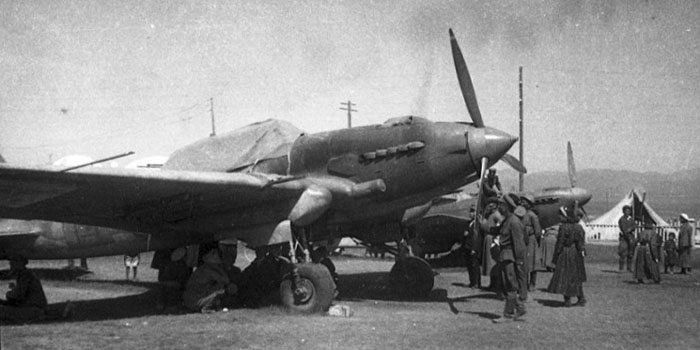
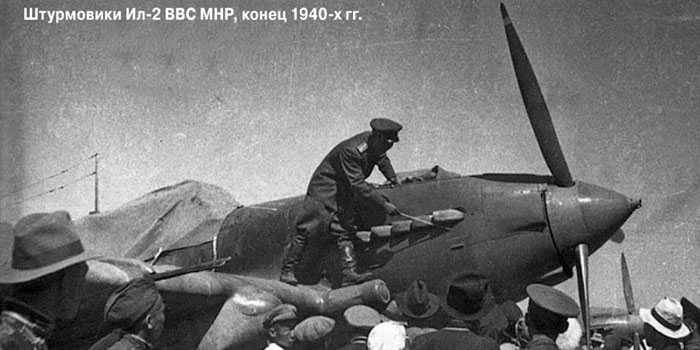
Side: further images of Mongolian Il-2 aside a Yak-9 after the war's end.
From http://aviadejavu.ru/Site/Crafts/Craft19941-3.htm#pics, http://aviadejavu.ru/Site/Arts/Art8979.htm and https://dambiev.livejournal.com/646794.html
The Il-2 of the photo is probably not the same of the photo above because some details are different, but it looks very similar.
The most interesting thing is that Mongolian markings are visible both under the wing and on the fuselage sides, but the emblem and outlines seem as black. Supposing that the emblem was the same, one can consider that yellow can appear similar to white on some bw films, and as black on ortochromatic ones. This suggests that both the emblem and outline of the Mongolian markings were yellow, that is consistent with we can see on sources as Wikipedia, not related to Il-2 in particular.
It is not clear if the emblem was a regular square or a bit higher than wider, nor if it was disposed with its top facing the front as usual for Soviet stars; its front looks parallel to the wing's leading edge.
The whole spinner of plane 24, and the front cone of the spinner of this plane, are clearly painted with a light and glossy marking color; it doesn't match the red nor the yellow of the national insignias, so the most likely alternative is blue.

A reconstruction of the look of Mongolian plane 24.
Click on the profile to see a larger 3 views drawing.
















